新概念英语第一册Lesson5教案
新概念英语第一册 Lesson 5完整版本
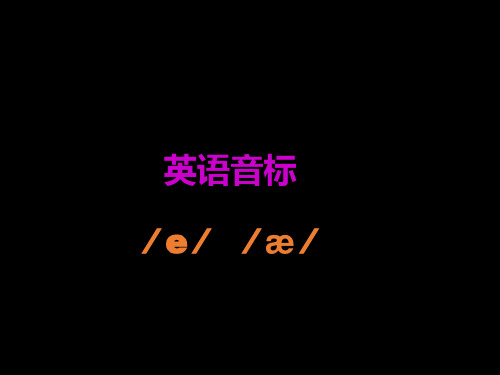
疯狂的 事实
男人 旗帜
手 猫 抓住 老鼠
Lesson 5 Nice to meet you.
he
China 中国
Chinese 中国人
Japan 日本
[dʒə‘pæ n]
he
she
Japanese 日本人
[‘dʒæ pə’ni:z]
Korea 韩国
[kə’riə]
he Korean 韩国人
[kə’riən]
再见
good bye
晚安
good night
祝你好运 good luck
课文讲解
• Good用法拓展 • 1,be good at 善于,在 …方面学的好 • 2,be good to sb 对某人好 • 3,be as good as one’s words 说话算数 • 4,as good as 和…一样好
he
France 法国
[fra:ns]
French 法国人
[frentʃ]
he
Germany 德国
[’dʒə:məni]
巴拉克
German 德国人
[’dʒə:mən]
某国
(中) China [‘t∫aɪnə]
(日) Japan [dʒə‘pæ n]
(韩) Korea [kə’riə]
(德) Germany [’dʒɜ:məni]
• ② adj. 和蔼的,友好的 He is very nice to his neighbours.
• ③ adj. 使人高兴的,令人愉快的 It is so nice to have you here.
too
• adv.用于肯定句中(强调也) • adv.太过于…… • eg:She talks too much.
新概念英语第一册Lesson5-6笔记(语法点+配套练习+答案)
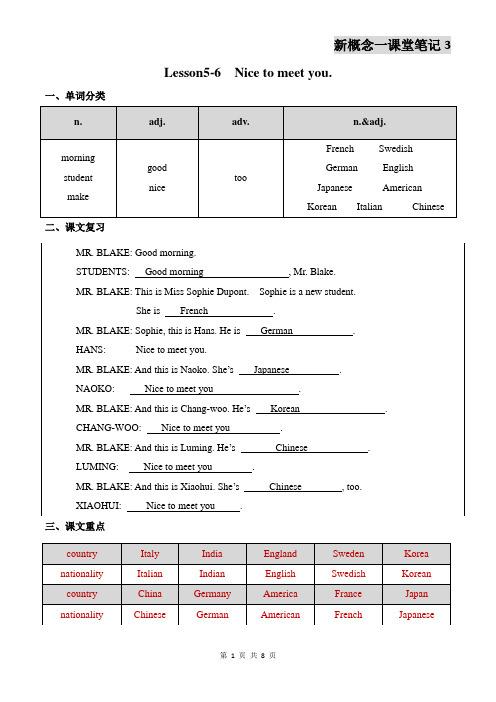
MR. BLAKE: And this is Naoko. She’sJapanese.
NAOKO:Nice to meet you.
MR. BLAKE: And this is Chang-woo. He’sKorean.
CHANG-WOO:Nice to meet you.
一般疑问句:Is it an American car?
I am a student.
否定句:I am not a student.
一般疑问句:Are you a student?
3.肯定句变特殊疑问句:
1.变成一般疑问句
2.找出特殊疑问词,放句首
3.划线部分去掉
4.后跟问号
4.对车牌进行提问,用what make
7.---What nationality is she?---She isKorean(Korea).
8. In America people speak English.
9. People in Italy speak Italian.
10. People in Sweden speak Swedish.
Italy
India
England
Sweden
Korea
nationality
Italian
Indian
English
Swedish
Korean
country
China
Germany
America
France
Japan
nationality
Chinese
German
American
French
新概念英语第一册Lesson5-6Nicetomeetyou小学英语-教学设计教案-初中英语全国通用
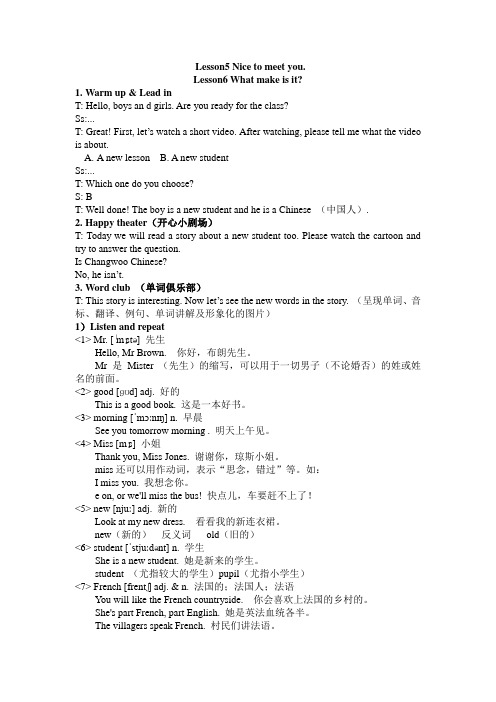
Lesson5 Nice to meet you.Lesson6 What make is it?1.Warm up & Lead inT: Hello, boys an d girls. Are you ready for the class?Ss:...T: Great! First, let’s watch a short video. After watching, please tell me what the video is about.A.A new lessonB. A new studentSs:...T: Which one do you choose?S: BT: Well done! The boy is a new student and he is a Chinese (中国人).2.Happy theater(开心小剧场)T: Today we will read a story about a new student too. Please watch the cartoon and try to answer the question.Is Changwoo Chinese?No, he isn’t.3.Word club (单词俱乐部)T: This story is interesting. Now let’s see the new words in the story. (呈现单词、音标、翻译、例句、单词讲解及形象化的图片)1)Listen and repeat<1> Mr. [ˈmɪstə] 先生Hello, Mr Brown. 你好,布朗先生。
Mr 是Mister (先生)的缩写,可以用于一切男子(不论婚否)的姓或姓名的前面。
<2> good [ɡʊd] adj. 好的This is a good book. 这是一本好书。
新概念英语第一册Lesson5Nicetomeetyou(课件)
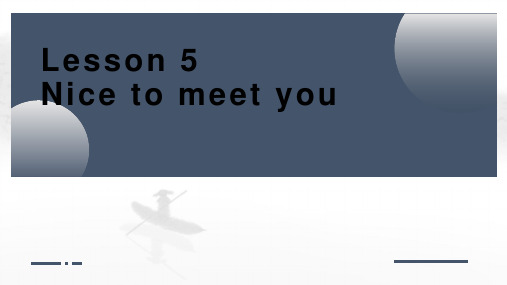
• student学生 • a new student • teacher老师 • many students许多学生 • There are many students in the playground. • 操场上有许多学生
• French法国人 • France法国 • I come from 我来自... • I am from... • I am French我是法国人
• meet遇见 • Nice to meet you • meet-met(过去式) • meet them.遇见他们
• Japanese日本人 • Japan日本 • He is from Japan. • We are not Japanese.我们不是日本人 • Whereห้องสมุดไป่ตู้do you come from
• German德国人 • Germany德国 • She is German. • She comes from Gemany. • 她来自德国
• nice美好的 • a nice girl • be nice to sb对某人好 • nice to meet you很高兴见到你 • What a nice day!
• Sophie,this is Hans. • He is German. • Nice to meet you. • 很高兴见到你 • 索菲亚,这是汉斯。 • 他是德国人
• And this is Naoko. • She is Japanese. • Nice to meet you • 这是直子 • 她是日本人 • 很高兴见到你
• Good morning. • 早上好 • Good morning,Mr.Blake • 早上好,布莱克先生
新概念英语第一册Lesson5-6课

在英语口语中,如果希望别人给自己“出 示” 什么东西时,通常是“要什么直接说什 么”。
eg: 请出示你的票。 Your ticket, please. 请让我看看你的护照。 Your passport, please. 请告诉我你的名字。 Your name, please.
Swedish
Stockholm is ___________
Swedciasphital.
Sweden 瑞典 Swedish 瑞典人
瑞典的
Remember ?
国家:
Fill in the blanks:
1.He is from Japan. He's _J_a_p_a__n_e_s_e_.
England 英国 English 英国人
英国的
It's from America.
American
It's
an_A__m__e_r_i_c_a_n__president.
America 美国 American 美国人
美国的
It's from Switzerland.
Swit Swiss
Lesson 5&6
Where is it from ?
It's from China.
Chinese
It's a _C_h__in__e_s_e_cartoon.
China Chinese
中国
中国人 中国的
It's from Japan.
Japanese
It's
a_J_a__p_a_n__e_s_e__mountain.
Thank you, sir. Number five.
新概念英语第一册第五课教案+练习
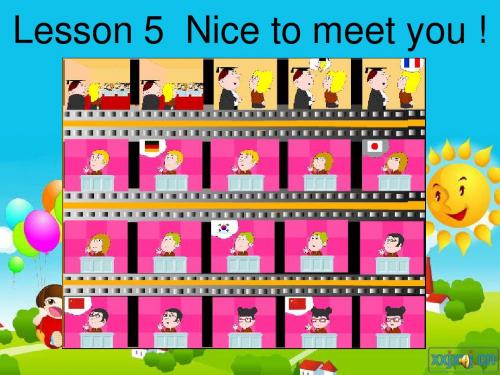
三. Write these with short forms : Here is your pen .Here’s your pen . 1.It is not American . 2.It is English . 3.He is Italian . 4.She is not Japanese . 5.That is a teacher . 6.He is not French . 7.She is German .
Lesson 5 Nice to meet you !
一. Fill in the blanks: :
Good morning !
Good morning , Mr Blake .
This is Miss Sophie Dupont .
Sophie is a new student .
She is French .
四. Chant :
系动词Be顺口溜: 系动词 顺口溜:am 、 is 、are 顺口溜 过去式: 过去式: was 、 were I am , He is , You are . This is , That is , These are , Those are. “是” 是
The end !
Sophie ,This is Hans .
He is Gerice to meet you .
二. Translate the following into chinese: :
布莱克先生:早上好。 布莱克先生:早上好。 早上好,布莱克先生。 学 生: 早上好,布莱克先生。 布莱克先生:这位是索菲娅.杜邦小姐 杜邦小姐。 布莱克先生:这位是索菲娅 杜邦小姐。 索菲娅是个新学生。她是法国人。 索菲娅是个新学生。她是法国人。 布莱克先生:索菲娅,这位是汉斯。他是德国人。 布莱克先生:索菲娅,这位是汉斯。他是德国人。 很高兴见到你。 汉 斯: 很高兴见到你。 布莱克先生:这位是直子。她是日本人。 布莱克先生:这位是直子。她是日本人。 很高兴见到你。 直 子: 很高兴见到你。 布莱克先生:这位是昌宇。他是韩国人。 布莱克先生:这位是昌宇。他是韩国人。 很高兴见到你。 昌 宇: 很高兴见到你。 布莱克先生:这位是鲁明。他是中国人。 布莱克先生:这位是鲁明。他是中国人。 很高兴见到你。 鲁 明: 很高兴见到你。 MR. BLAKE: And this is Xiaohui. 布莱克先生:这位是晓惠。她也是中国人。 布莱克先生:这位是晓惠。她也是中国人。
新概念英语第一册 Lesson5~6带答案)(共40张PPT)

记忆面包条 --好句推荐 This is … 用来介绍某人,这是... Nice to meet you. 见到你很高兴。
Grammar
1. 不定冠词的使用
冠词: 不定冠词(a, an) 定冠词(the)
三个冠 词 the an
a
分类
定冠词 不定冠 词
不定冠 词
用法
详见L25-26 重点语法2
2.雨 水 管 、 污 水管 发生堵 塞、冒 溢; 3.门 、 窗 安 装 不密 闭,出现 翘裂; 4.墙 面 、 顶 棚 抹灰 层脱落 ; 5.照 明 线 路 发 生故 障;
屋 面 防 水 保 修3年,其 他部 位、部 件的保 修期限 ,由房地 产开发 企业与 用户自 行约定 。
因 住户使 用、装 修不当 或
Vocabulary
(6) 国家和国籍
France
I am French.
Vocabulary
Germany
I am German.
Vocabulary
Japan I am Japanese.
Vocabulary
Korea
I am Korean.
I am Korean , too
Vocabulary
Vocabulary
课文原句重现:She is French. 表达:表示国籍的名词前通常没有冠词。表示国 籍的词,首字母要_大_写______。 判断对错:
I am Chinese. (__√__) I am a Chinese. (_×___)
Vocabulary
(7) nice adj. 美好的 e.g. _T_h_i_s_d_r_e_s_s_i_s _v_e_ry__n_ic_e_.__________.
新概念英语第一册 Lesson 5完整版本

• 掌握两课中的单词及专业词汇。 • 熟练运用课堂所讲解的日常用语。
What is the country?
• China • Japan • Korea • France • England
Chinese Japanese Korean French English
课文讲解
• Morning用法拓展 • 1,in the morning
• 2,在星期天早上: on Sunday morning • 3,在一个冬天的早晨: on a winter morning
• Eg:I go to school____8 o’clock in the morning. A.at B.in C.on D.for
he
France 法国
[fra:ns]
French 法国人
[frentʃ]
he
Germany 德国
[’dʒə:məni]
巴拉克
German 德国人
[’dʒə:mən]
某国
(中) China [‘t∫aɪnə]
(日) Japan [dʒə‘pæ n]
(韩) Korea [kə’riə]
(德) Germany [’dʒɜ:məni]
What is the country?
• America • Italy • Sweden • Germany
American Italian
Swedish German
Details on new words
• 国家及人的表达: • 1、-ese: ____________________ • 2、-n: ______________________ • 3、-ish: _____________________ • 4、-ch: _____________________
- 1、下载文档前请自行甄别文档内容的完整性,平台不提供额外的编辑、内容补充、找答案等附加服务。
- 2、"仅部分预览"的文档,不可在线预览部分如存在完整性等问题,可反馈申请退款(可完整预览的文档不适用该条件!)。
- 3、如文档侵犯您的权益,请联系客服反馈,我们会尽快为您处理(人工客服工作时间:9:00-18:30)。
Lesson5 Nice to meet you. 很高兴见到你。
一、教学任务:Back vowels & special question,特殊疑问句,及小词Nice to meet you.二、教学目标:1. 学生掌握特殊疑问句的结构及常用疑问词2. 会使用This is来介绍他人3. 掌握后元音的读音三、教学重点:后元音和特殊疑问句四、教学难点:特殊疑问词的掌握五、教学过程:1. Review the Phonetic alphabet2. Back V owels <发音时舌后部抬起的音叫后元音>[a:]小汽车car --- 带读--- 点线面---ask字母ar发什么音。
发音规则:嘴巴张得最大,舌身平放后缩,舌尖离开下齿。
带读点答[ɒ] dog 狗--- 带读--- 点线面--- ask字母o发什么音发音规则:双唇稍稍收圆,舌身尽量降低并后缩(不要突出)带读点答[ɔ:]ball球---带读--- 点线面--- ask字母al发什么音。
发音规则:舌后部抬得比[ɒ]略高,双唇也收的更圆更小,并向前突出。
带读点答[ʊ]book书---带读---点线面--- ask字母oo发什么音。
发音规则:发音时舌后部抬起,边发音边把下嘴唇往回收。
带读点答[u:]blue 蓝色的---带读--- 点线面--- ask字母u发什么音。
发音规则:发音时舌后部抬的比[u]高,双唇收的比[u]更圆更小。
带读点答A.呈现:---汽车how to say?(car)---letter ‘ar’ how to pronounce?( [a:])<带读,点读,教发音规则,做手势>---狗how to say?(dog)--- the last le tter ‘o’ how to pronounce?( [ɒ])<带读,点读,教发音规则,做手势>---球how to say?(ball)---letter ‘al’ how to say?( [ɔ:])<带读,点读><教发音规则,做手势>---书how to say?(book)---letter ‘oo’ how to say?( [ʊ])<带读,点读><教发音规则,做手势>---蓝色的how to say?(blue)---letter ‘u’ how to say?( [u:])<带读,点读><教发音规则,做手势>B.总结:---这几个音都是?音(元音)--- Why? (气流没有受到嘴巴的阻碍) ---T: Read the vowelstogether, what’s the common ground? How about our tongue? (都是舌头后部需要隆起) --- Great, sowho can give them a name? (后元音) --- Wonderful, tell me, what is back vowel? (舌头后部隆起的元音叫后元音)--- I will have a check, 读对几个加几分C. Word: 拼读---拼写---过关morning ['mɔ:nɪŋ]早晨student['stju:dənt,]学生German['dʒə:mən]德国人T: How many vowels, how many syllables(有多少元音就有多少音节) ---Look at this word, Howmany vowels? (Two) ---How many syllables? (Two) --- What is the first vowel? ([ɔ:]) --- What is thesecond vowel? ([ɪ]) --- <S每找出一个元音T划出一个音节;每次增加一个辅音让S拼读时T划下画线标注> [mɔ:] how to read?---[ɪŋ] how to read? ---[nɪŋ] how to read? --- 重音在第几个音节(第一个)--- read them together. ['mɔ:nɪŋ] ---带读,过关--- <Fast reaction> [ɔ:]which letters? (or) --- [ɪ]which letter? (i) <点答过关> ---[m] which letter? (m) --- [n] which letter? (n) --- [ŋ] which letters?(ng) ---[mɔ:] which letters?(mor) ---[nɪŋ]which letters? (ning) --- [mɔ:nɪŋ] how to spell? (morning )3. Grammar一、Nice to meet/see you! 见到你很高兴!回答:Nice to meet/see you , too见到你也很高兴!二、将别人介绍给他人时,用this is…..A. 呈现:---T ask Ss: Who want to have a talk with me? --- (S…) --- Hello, what’s your name? (Myname is ...) --- Oh, *** , nice to meet you. (Nice to meet you, too)--- (tell another students)This ismy friend,****, please remember his name. <introduce another students>B. 讲解:--- Ok, please tell me: what did I do just now? (交朋友,然后把朋友介绍给别人) --- good,那么我们交到朋友了,要对他说?(Nice to meet you)<板书,带读,背诵> --- what’s the meaning?( 很高兴见到你。
) --- how to answer? ( Nice to meet you, too. ) <板书,带读,背诵> --- what’s the meaning? ( 也很高兴认识你) ---“见”除了meet 还可以用?(see)<表情+动作>--- 所以这句话还可以怎么说(Nice to see you!)---回答?(Nice to see you,too.)--- What’s the meaning?(也很高兴见到你。
) --- Very good, 那老师是如何向别人介绍我的朋友呢?(This is my friend,****)--- so 介绍别人可以用?(This is…)--- Brilliant,现在请你们来交朋友,然后把你的朋友介绍给Helen。
二、特殊疑问句:1)、由特殊疑问词引导。
2)、结构:特殊疑问词+一般疑问句3)、特殊疑问词有:what表什么, which表哪一个, when表什么时候,where什么地点, why 表为什么,who 表谁,how表怎么样A. --- Ask one student: what’s y our name? ( My name is ***. ) <板书,带读,背诵> --- ? 句(肯定句) --- ‘is’ what’s the part of speech?(be动词) --- Please change it into a general question. ---Is your name***? <板书,带读,背诵> --- How do you change it? (把be动词提到句首,一二人称互换) --- How to answer? (Yes, it is./ No, it isn’t.) --- 所以一般疑问句必须用?回答(Yes/ No) --- Good, you should remember it. --- Ask one student: please change it, 我们在名字下面画线,说明它是?(未知的)<老师用手挡着划线部分>,那么我们就需要对划线部分进行?(提问)--- 用中文要如何问?(你叫什么名字) --- How to say? (What is your name?) <板书,带读,背诵> --- What’s the sentence pattern? (疑问句) --- How do you know?(问号) --- 它是一般疑问句吗(不是) --- Why? (因为它的回答不用yes/ no) --- 那么对这个特殊部分提问的句子,we can call it?(特殊疑问句) --- How to answer? (My name is...) --- 这个答句是一个?的句子?(完整的句子)--- 所以特殊疑问句回答要是?(完全地回答)--- 除此之外,特殊疑问句不同于一般疑问句的特点是?(不能用yes或no来回答)--- 这个句子由哪个词引导(what) --- 引导特殊疑问句的词,we call it?(特殊疑问词)--- so 特殊疑问句由?词引导(特殊疑问词)--- ‘is your name’ what’s the sentence pattern?(一般疑问句) --- Why? (be动词放在了句首)--- so特殊疑问句的构成是?(特殊疑问词和一般疑问句)‘what’?词(特殊疑问词)--- What’s the meaning?(什么)--- 除了what,还有别的特殊疑问词吗?B.PracticeC→E:1.丽丽在教室里。
2.这是一只钢笔。
对划线部分提问:。
